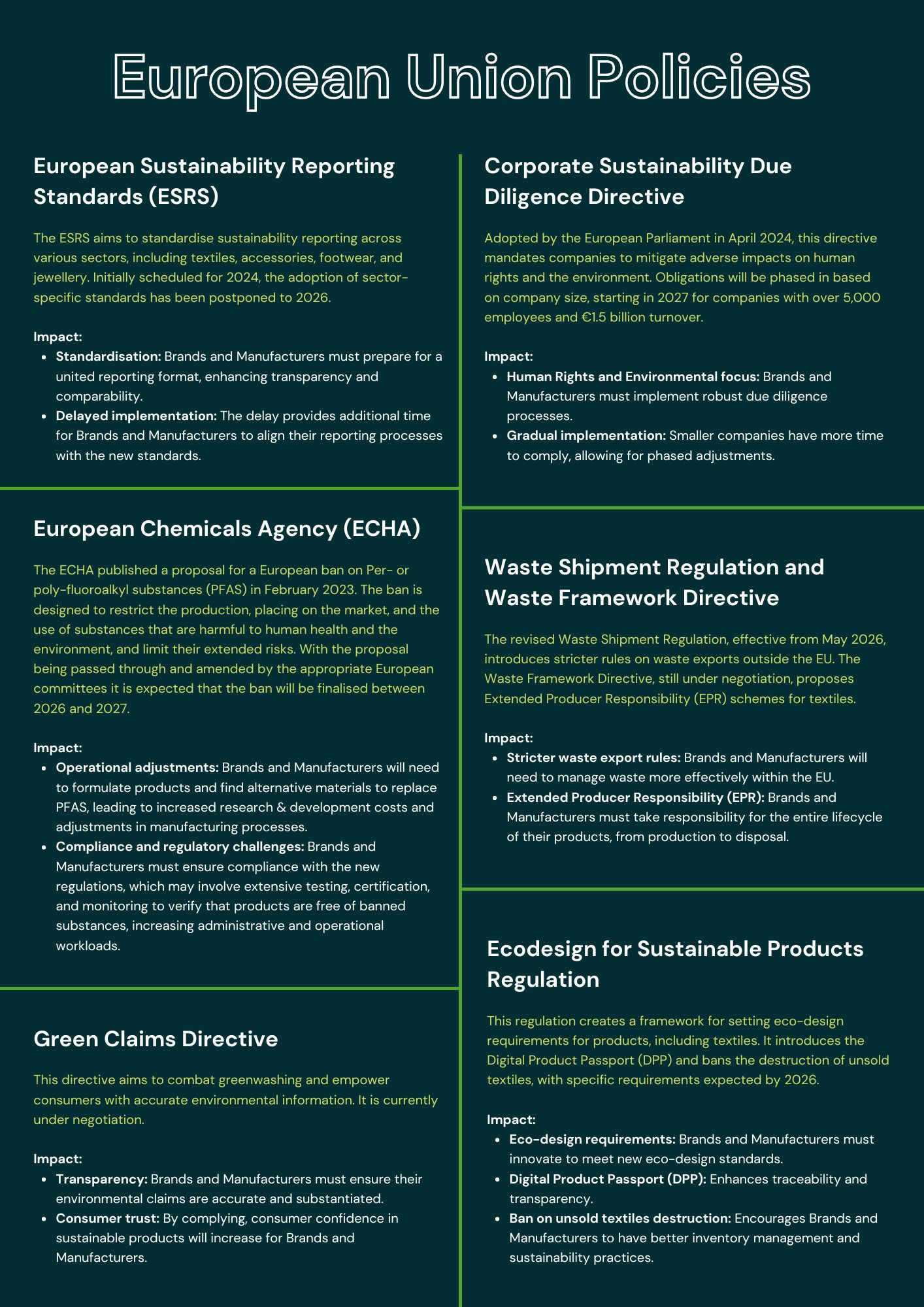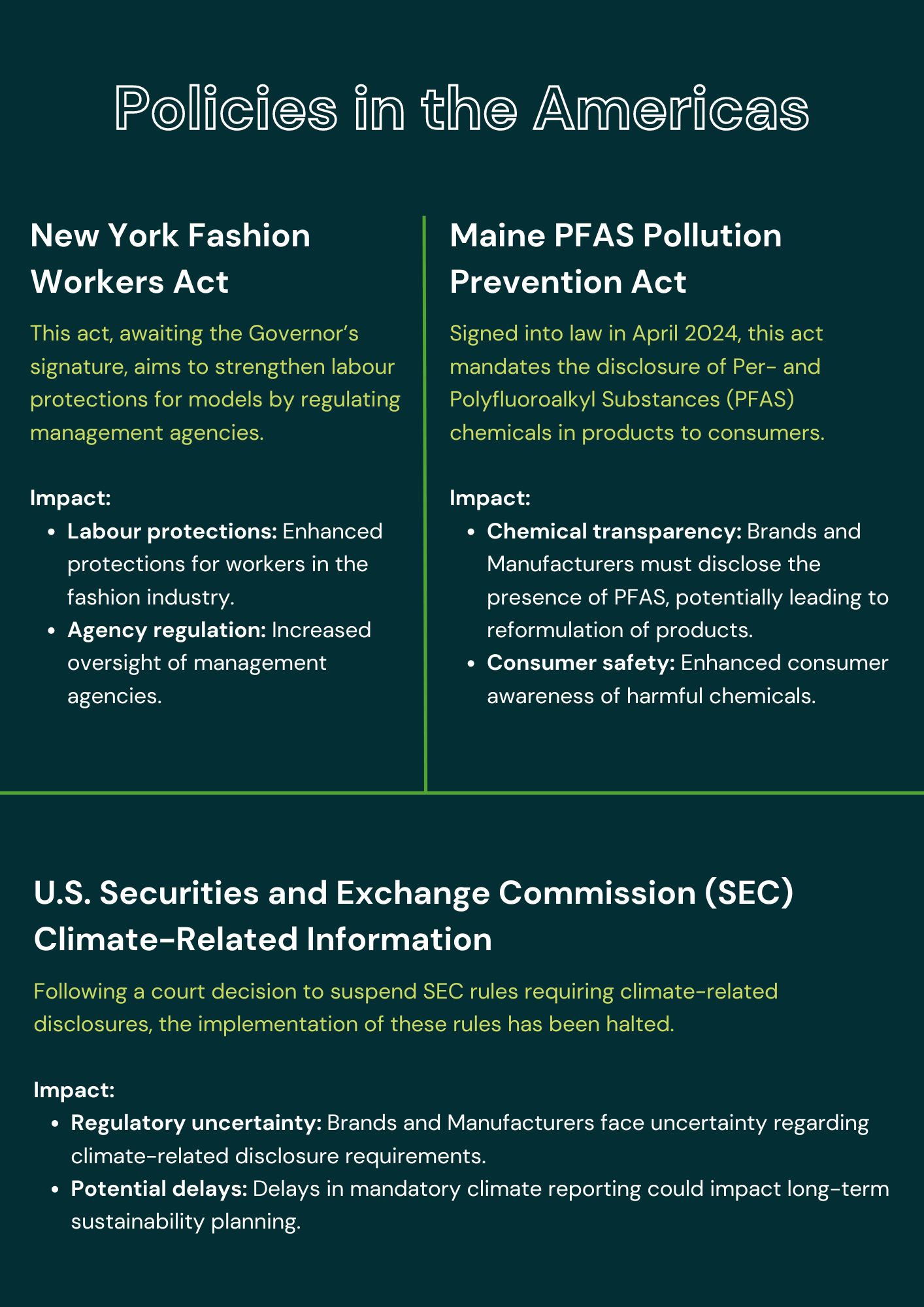The textile industry is on the brink of significant transformation driven by the latest policies in the European Union (EU) and the Americas. Brands and Manufacturers must understand the implications of these regulations to remain compliant and competitive. Delve into the latest policies and discover their potential impact on Brands and Manufacturers.
Key takeaways for Brands and Manufacturers
Sustainability, transparency, and environmental responsibility are the major consistencies across the latest EU and American textile policies. But Brands and Manufacturers must focus on:
- Preparing for standardised reporting: Align sustainability reporting processes with the European Sustainability Reporting Standards (ESRS) and similar standards in the Americas.
- Implementing due diligence: Develop robust due diligence procedures to monitor and mitigate adverse impacts on human rights and the environment.
- Adapting to waste regulations: Enhance waste management practices in-line with new EU directives, such as the EU’s Waste Framework Directive and similar waste management laws in the Americas.
- Promoting transparency: Ensure environmental claims are accurate and substantiated to build consumer trust, in line with directives like the EU’s Green Claims Directive.
- Designing for durability and repairability: Innovate to meet new eco-design and repairability standards.
- Monitoring regulatory changes: Stay informed about regulatory developments in both the EU and the Americas.
Shared international approach
Both regions are emphasising sustainability reporting and due diligence. In the EU, the ESRS mandate standardises reporting formats, while in the Americas, regulatory initiatives like the SEC climate-related disclosures push for transparent sustainability reporting. Additionally, both regions are strengthening regulations around environmental impacts and human rights, such as the EU’s Corporate Sustainability Due Diligence Directive and the New York Fashion Workers Act. These measures necessitate that Brands and Manufacturers develop comprehensive reporting and due diligence processes to ensure compliance.
Both the EU and the Americas – through the European Chemicals Agency (EU) and the Maine PFAS Pollution Prevention Act (Americas) – are looking to moderate the environmental impact of chemicals used in textile dyeing. These aim to ban PFAS. PFAS – Per- or Poly-fluoroalkyl Substances – are toxic, industrial chemicals which can enter our bloodstream through our skin. PFASs are found in many products, such as raincoats, outdoor wear, and sportswear. Often referred to as “forever chemicals” they resist breaking down, are capable of withstanding high temperatures, and are resistant to oil and water.
The US have already signed the Maine PFAS Pollution Prevention Act into law, as of April this year, and the EU is expected to ban PFAS between 2026-27. Consequently, both regions are pushing Brands and Manufacturers – and the fashion industry as a whole – to actively eliminate PFAS from their products and to support policies regulating the industry. However, this presents both challenges and opportunities for innovation.
The removal of PFAS from supply chains and adopting alternative materials can be costly and may require significant investment in research and development. Implementing such PFAS measures may cause global supply chain disruption due to needing adjustments and coordination across international markets. Let alone companies trying to find substitutes to achieve the same results as with PFAS which can be difficult. For example, bio-based materials and/or tightly woven fabrics. Despite this, leading brands like Levi’s, H&M, and Patagonia are already finding, using, and implementing safer alternatives. Therefore, with time, investment and research, Brands and Manufacturers will move forward with safer alternatives to comply with these changing policies and improve consumer safety.
Challenges
Like any change, these policies present challenges and opportunities for Brands and Manufacturers. When implementing these policies, Brands and Manufacturers are likely to face:
- Complex compliance: Navigating the complexities of multiple overlapping regulations across different regions can be daunting and resource intensive.
- Cost of implementation: Developing and maintaining robust reporting, due diligence, and waste management systems can entail significant costs, particularly for smaller firms.
- Adapting to change: Rapidly evolving regulations require continuous adaptation and can strain existing operational processes and resources.
Opportunities
However, by adopting standardised reporting and due diligence procedures, companies can:
- Enhance transparency: Protect consumers and build their trust by providing transparent and verifiable information about their sustainability practices.
- Drive innovation: Innovate in product design and manufacturing processes to meet new eco-design and waste management standards, such as those outlined in the EU’s Ecodesign for Sustainable Products Regulation.
- Gain competitive advantage: Companies that lead in compliance and sustainability can differentiate themselves in the market, appealing to increasingly environmentally conscious consumers and investors.
Adapting to change
The alignment of the EU’s and Americas’ policies around sustainability and transparency reflects an international shift towards responsible textile production practices. For Brands and Manufacturers, they should invest in comprehensive compliance systems and processes, which, while challenging, open avenues for innovation, market differentiation, and enhance consumer trust.
Therefore, Brands and Manufacturers must align with standardised reporting formats, implement due diligence for human rights and environmental compliance, adapt to new waste regulations, ensure accurate environmental claims, innovate for durability and repairability, and staying informed about regulatory changes in both the EU and the Americas. By proactively addressing these areas, Brands and Manufacturers will not only ensure compliance but also drive innovation and sustainability within the textile industry, committing to safe fashion while supporting long-term environmental protection.
Where Alchemie comes in
We at Alchemie welcome European and American policymakers driving meaningful change in the textile and fashion industry. Progressing to harmonised global legislation standards, and having adaptable regulations that evolve with technological advancements, will be key for future industry success as Brands and Manufacturers continue to adopt more sustainable processes.
Alchemie’s clean-tech production solutions provide the opportunity for supply chain traceability, with the introduction of the digital product passport (DPP). Across our technology, Brands and Manufacturers will have easy access to primary data for use in their garment life cycle assessments (LCAs), and sustainability reporting for consumers. What’s more, our technology supports improved textile waste management and reusability with our Discovery digital lab system using a reverse osmosis process to reuse dye rather than dispose of it, and Endeavour – like Discovery – can support reshoring for local production.
If you want to learn more about our clean-tech solutions, please visit Our Technology.

